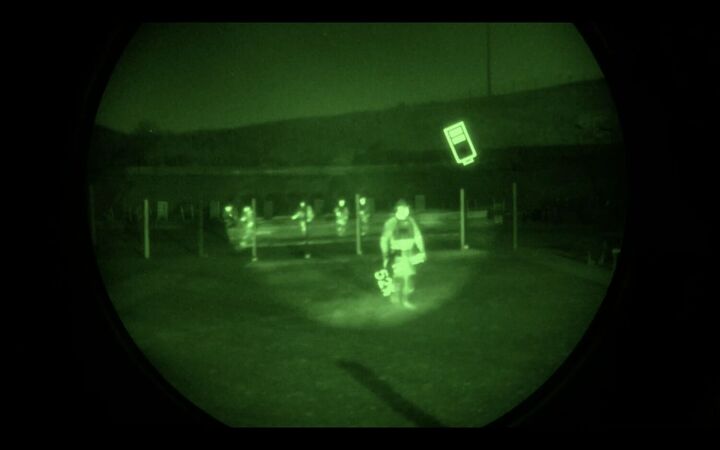Welcome back to another Friday Night Lights. This week I decided to take a step back in case we have some newer readers who are still deciding what they should buy next, night vision or thermal. That is a loaded question. Almost like deciding if you should buy a rifle or a handgun. It is all personal preference and while both can be used for some activities, they are better suited for specific tasks. They have their pros and cons and we will illuminate them.
Night Vision and Thermal @ TFB:
- Friday Night Lights: Shooting Long-Range Thermal – 1250 Yards
- Friday Night Lights: ABNV RPNVG – Ruggedized Panning Night Vision Goggle
- Friday Night Lights: DJI M2EA – Personal Thermal ISR Drone
Should You Buy Night Vision Or Thermal?
This is something only you can answer for yourself but perhaps I can help point out some pros and cons to help you make an informed decision. You need to decide what activity you want to pursue and that will help you choose night vision or thermal. Can’t you do everything with one or the other? You can try but that is like trying to eat everything with just a spoon or a fork.
Let’s focus on night vision. If your main priority is to see in the dark and not use a flashlight then night vision might be the answer for you. Just know that night vision or thermal will be somewhat expensive and you should set aside a couple to a few thousand dollars for a set. Seeing in the dark can be achieved by night vision or thermal but one does it better than the other. Yep, that’s right, night vision is the king of the dark. Actually, that is analog night vision. What do I mean by that? The classic image intensifier tubes based on cathode ray tube technology. Yes, the green, or in some cases white phosphor which actually looks bluish, that sometimes makes that high-pitched whining sound.
Analog night vision is extremely energy efficient. A single tube PVS-14 can run for 40 hours on a single AA battery! There are digital night vision systems out there but they are not efficient with battery life at all. A couple to a few hours at best. Plus they have a lag in the image. Analog night vision is like looking through a toilet paper tube. As you move around, the world on the other side of that tube doesn’t really move. But jiggle a digital night vision device and you will see the world slowly move up and down and streak until you stop moving and the digital sensor catches up. Also, digital systems are not high dynamic range. If you look at a bright light source, the digital sensor has to choose to show you what is outside that light or inside but not both. Analog night vision shows you both.
You can see through glass so driving a vehicle at night is possible. If you have the money you can buy panoramic night vision and see more.

Simulated POV looking through QTNVG while sitting in my FJ Cruiser.
Quad tubes were developed for A10 pilots with the ANVIS10. Later The GPNVG quad tube goggles were made for ground forces for CQB use.
So far, right vision seems like a perfect device for seeing in the dark right? Almost, but it has limitations. Night vision only amplifies light. It cannot see in absolute darkness and will need some ambient light to see. This is where infrared lasers or infrared illuminators come into play. Only night vision can see the infrared spectrum. Human eyes and animals do not see in the infrared wavelengths. Night vision also has a hard time seeing through particulates like smoke. It cannot see through it at all. Besides absolute darkness and particulates, you have something called photonics barriers. Imagine driving at night along a long highway with no one else but you. Your eyes are adapted to the dark and dilated. Then you come over a hill and another car in the opposite direction has its high beams on. How well will you be able to see? Not very well. Night vision suffers from this as well.
There are other limitations like camouflage. Night vision seems like a superpower but it only amplifies ambient light. Traditional camouflage can make it harder to see something like small game animals hiding in tall grass. I do not find night vision to be that great for hunting reasons specifically for that reason. However, night vision is very high resolution. You can make out detail and positively ID what you are looking at. See the image below. You can clearly see the different gear each individual is wearing. If I told you the target is the guy with dark kneepads and dark chest rig, you would know who I was talking about.

In some special instances, like the PVS-21 goggles, you can see color through the night vision image.

So Should I Still Buy Night Vision or Thermal?
Are you a hunter? If you want to hunt at night to eradicate pests such as coyotes and feral hogs, then thermal is the answer for you. Night vision is great but thermal is king for detecting game.
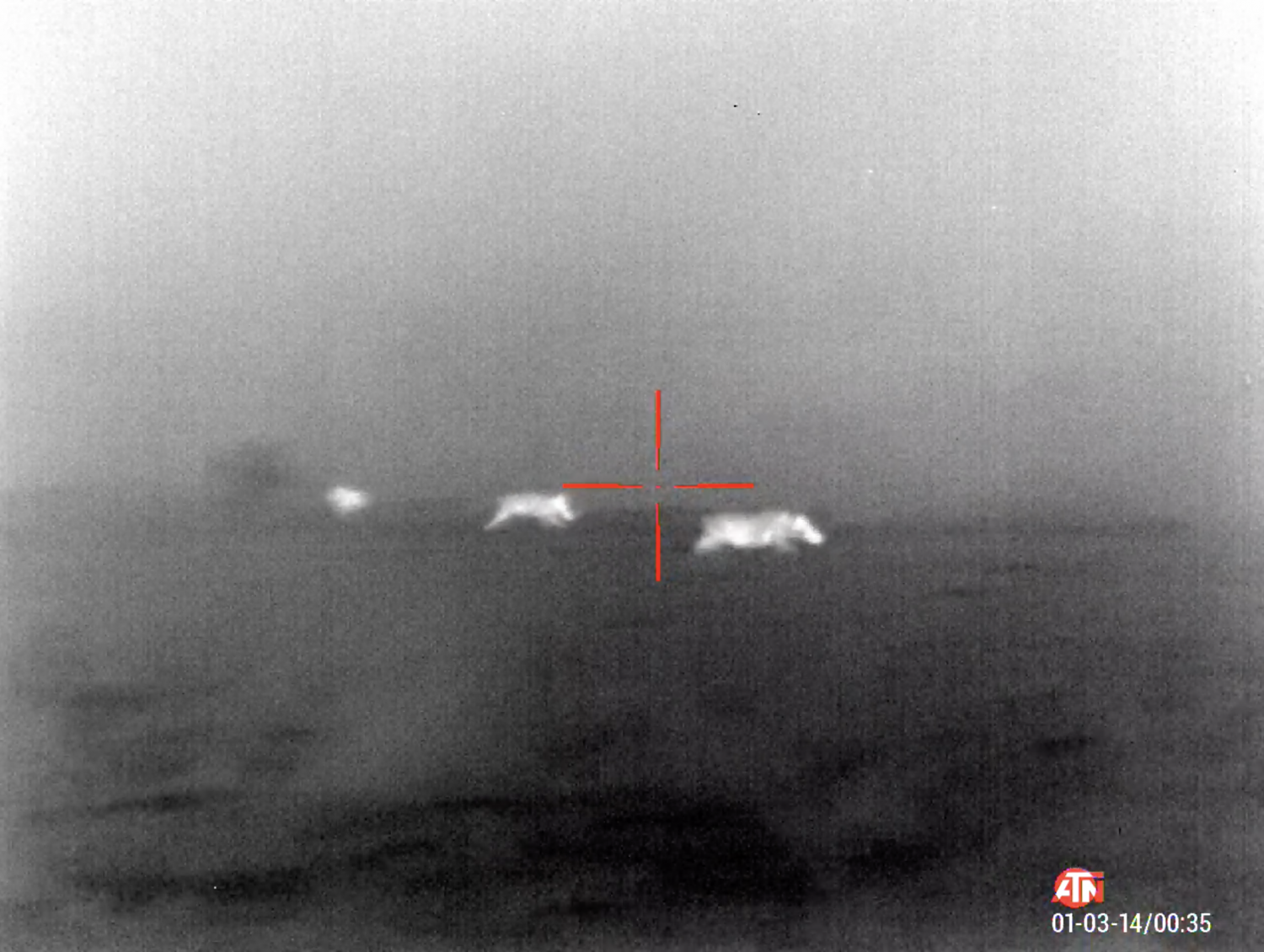
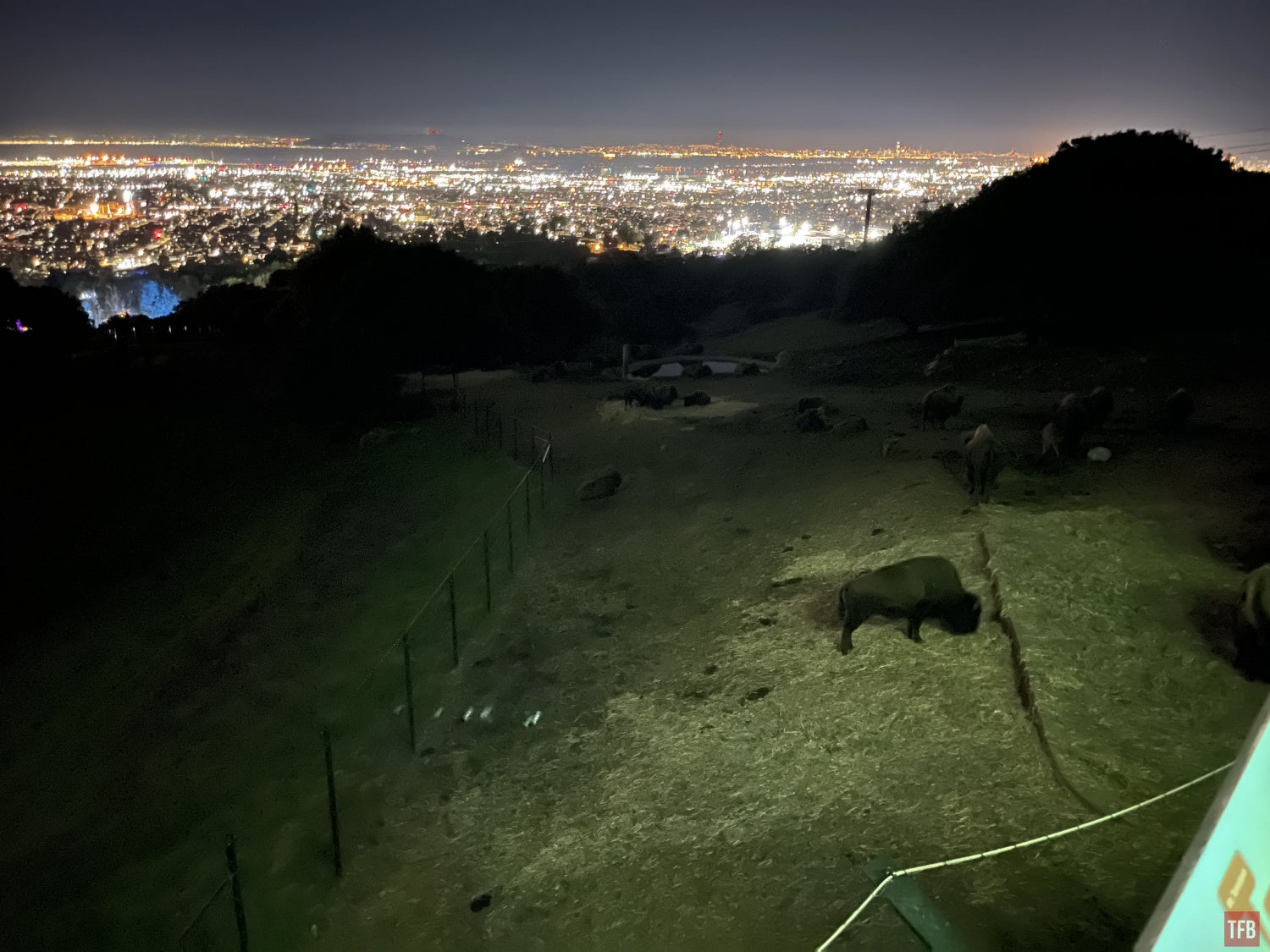
Photo taken with iPhone 12 max pro. The low light image isn’t bad but it is a bit hard to see the buffalo past the area of illumination.
I superimposed the thermal from my SKEETIRL over the iPhone picture. You can see how small the FOV is but you can see the buffalo past the watering hole very easily.
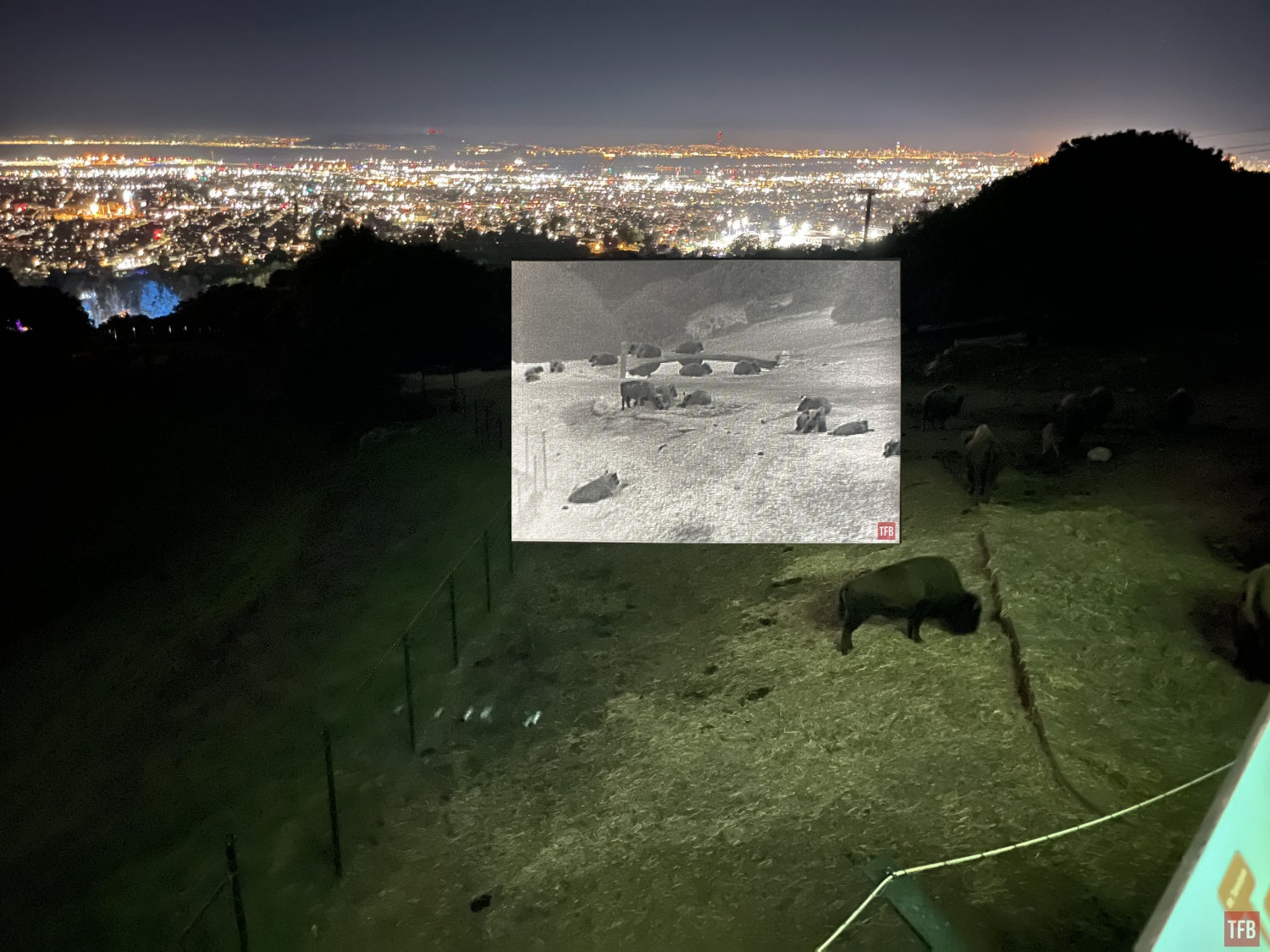
Thermal scopes make hunting at night super easy. But unlike night vision, they are power hungry. But not for political gain. They need a lot of electricity in the form of batteries. A lot of the small ones will suck a CR123 dry in under 2 hours. A lot of the bigger weapon-mounted units use multiple CR123s or large rechargeable batteries.
Besides power consumption issues, thermal cannot see light. So in the night vision or thermal conundrum, this can be both good and bad. Remember I said night vision cannot see in absolute darkness? Well, thermal can. It is also not affected by photonics barriers.

Night vision with light shining toward it. This is a phonic barrier.
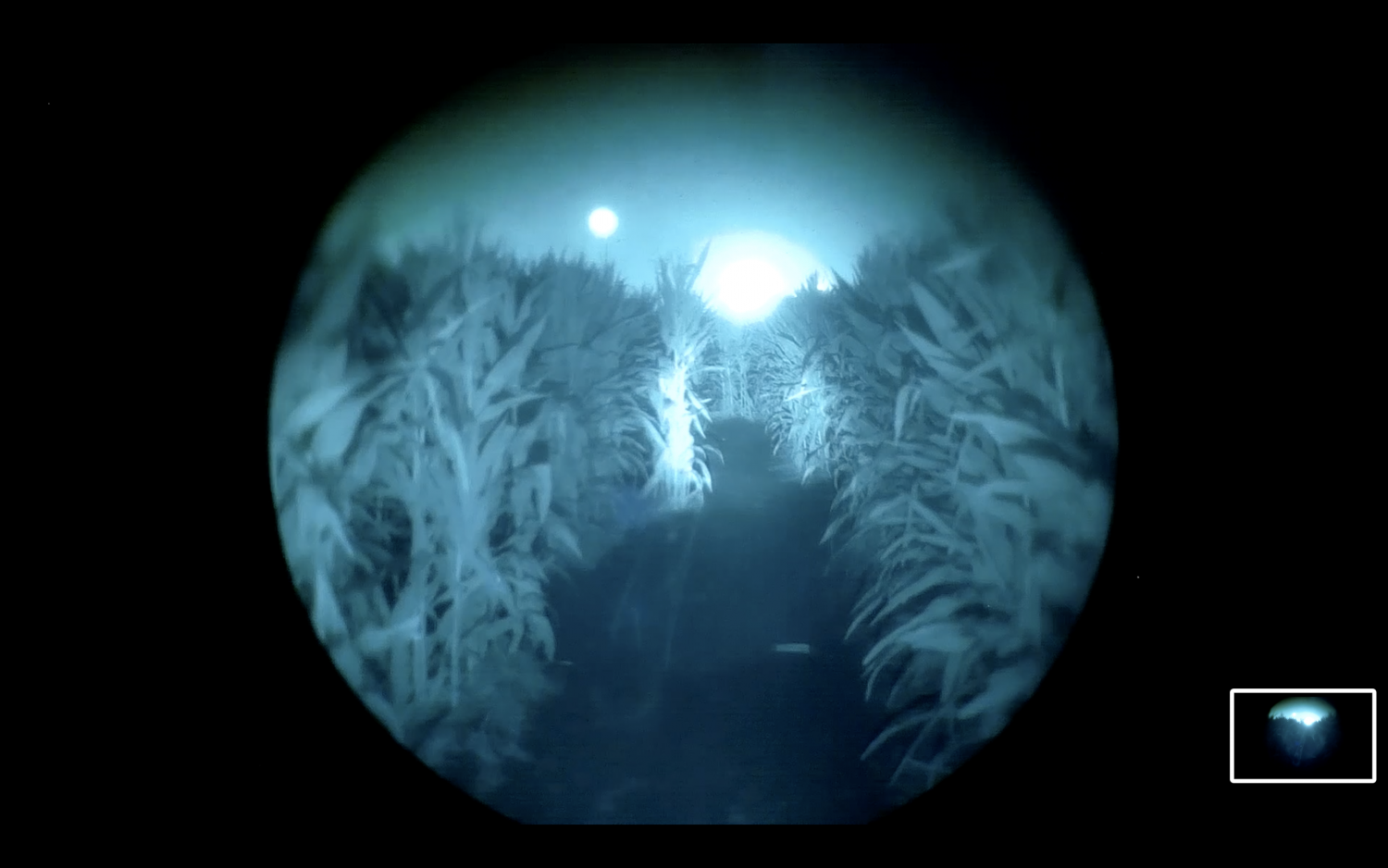
You can fight photonic barriers with light.

Or have thermal. This is a JerryC clip-on thermal imager. Even though the night vision has a hard time seeing down this row of corn, it can see my hand thanks to the thermal.
Thermal does not care how bright or dark the environment is. But this also means it cannot see lights or lasers. Often you will see something with thermal but to point it out to someone else with thermal is a challenge. You cannot just shine an infrared laser at the point of interest unless you both have night vision.
Another bummer about thermal is that it cannot see through glass. So driving with helmet-mounted thermal is out of the question. Plus, like digital night vision, most thermal have lag so it will be difficult to drive safely even if you don’t have windows.
Remember I said night vision cannot see through smoke? Thermal can. That is partially why firefighters use thermal. In this case, choosing between night vision or thermal is kind of easy.
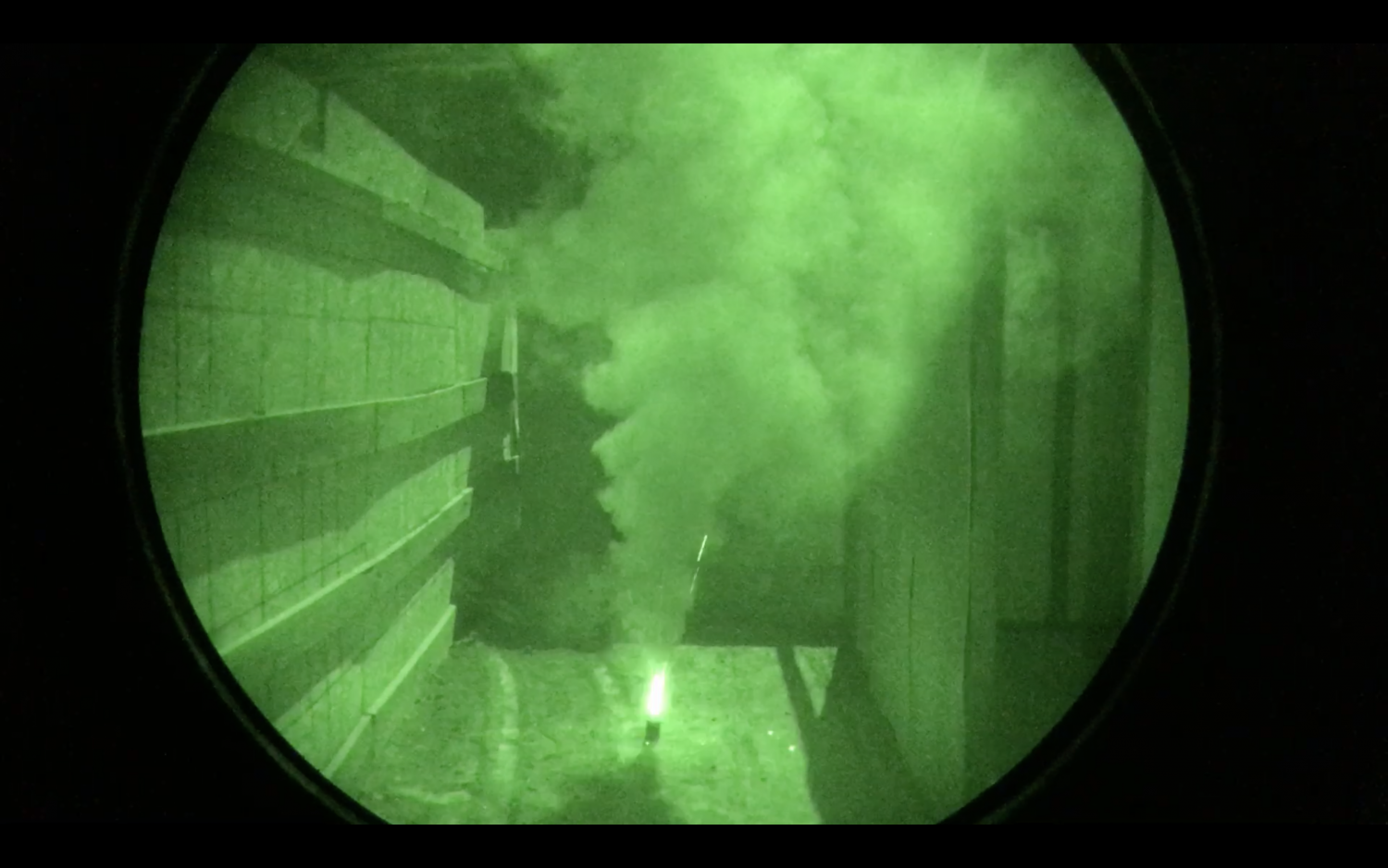
Night vision cannot see through the smoke.

Thermal fusion helps night vision see through the smoke.

Compare that to a pure thermal image. My friend who was standing on the other side of the smoke used my thermal monocular to film back at me. It doesn’t even show smoke in the image. As if it wasn’t even there.
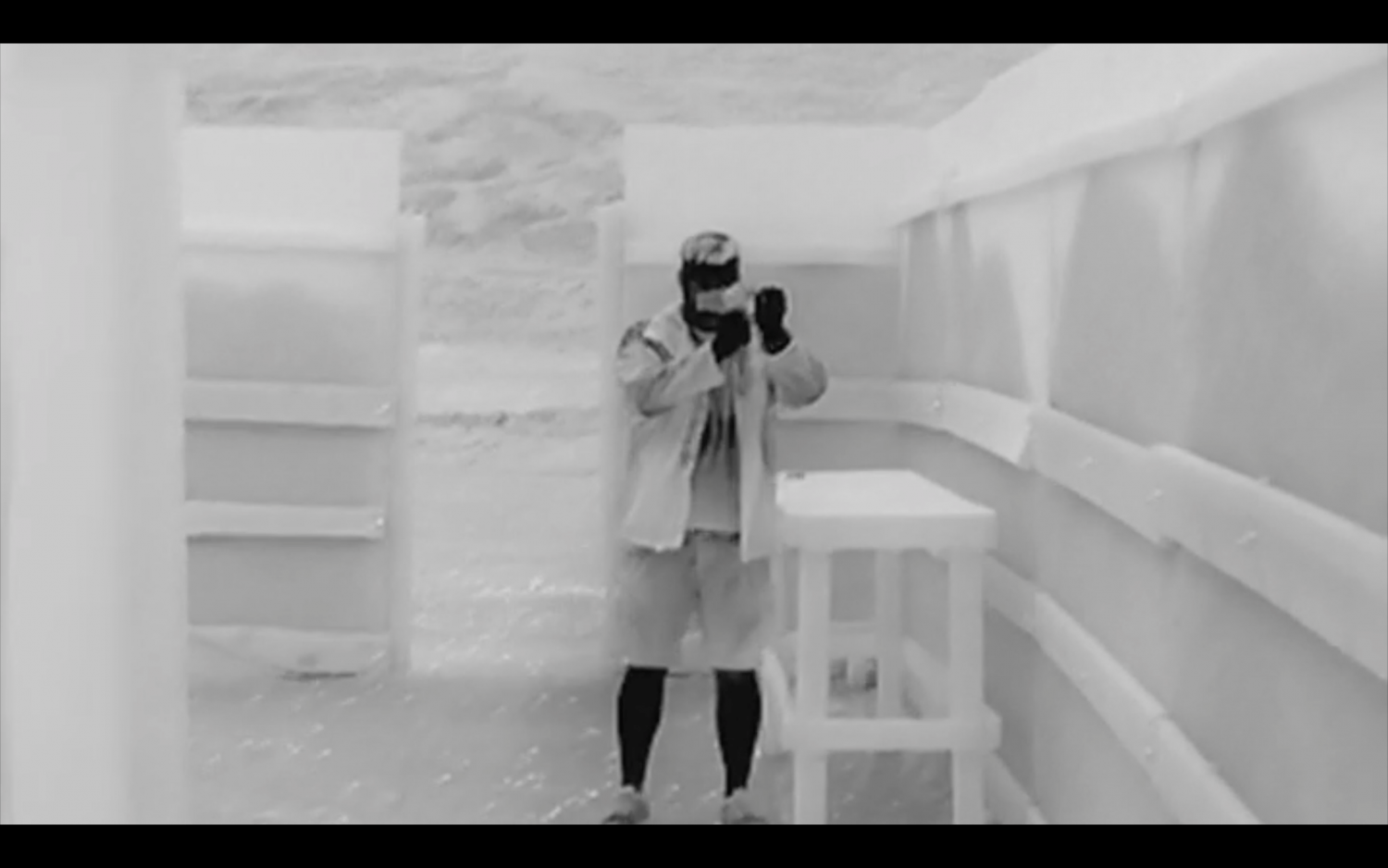
Remember I said thermal is great for hunting? I went on a nighttime hog hunt and used night vision as well as thermal. We got two hogs for sure but only found one of them. My hunting party asked if I could see any other bodies. I flipped my goggles down and spotted the other hog carcass instantly but not because I had night vision. I had a clip-on thermal imager. It showed the residual body heat of the hog through the bushes just past my hunting buddies.

Hunting buddies on the left looking at pig carcass on the ground. See the white speck past them in the middle of the night vision image? That is the other hog.

Sure enough, there was our second hog that ran into the bushes and died. But without thermal, I would not have detected them as easily with just night vision.
This brings us to another option in our question: night vision or thermal, and that is thermal fusion. Night vision augmented with thermal. It is a cool superpower to see both infrared and thermal but it has limitations. The size of the thermal lens and the software/processor is limited due to the small size. Up close it is easy to tell what kind of animal you are looking at with thermal.
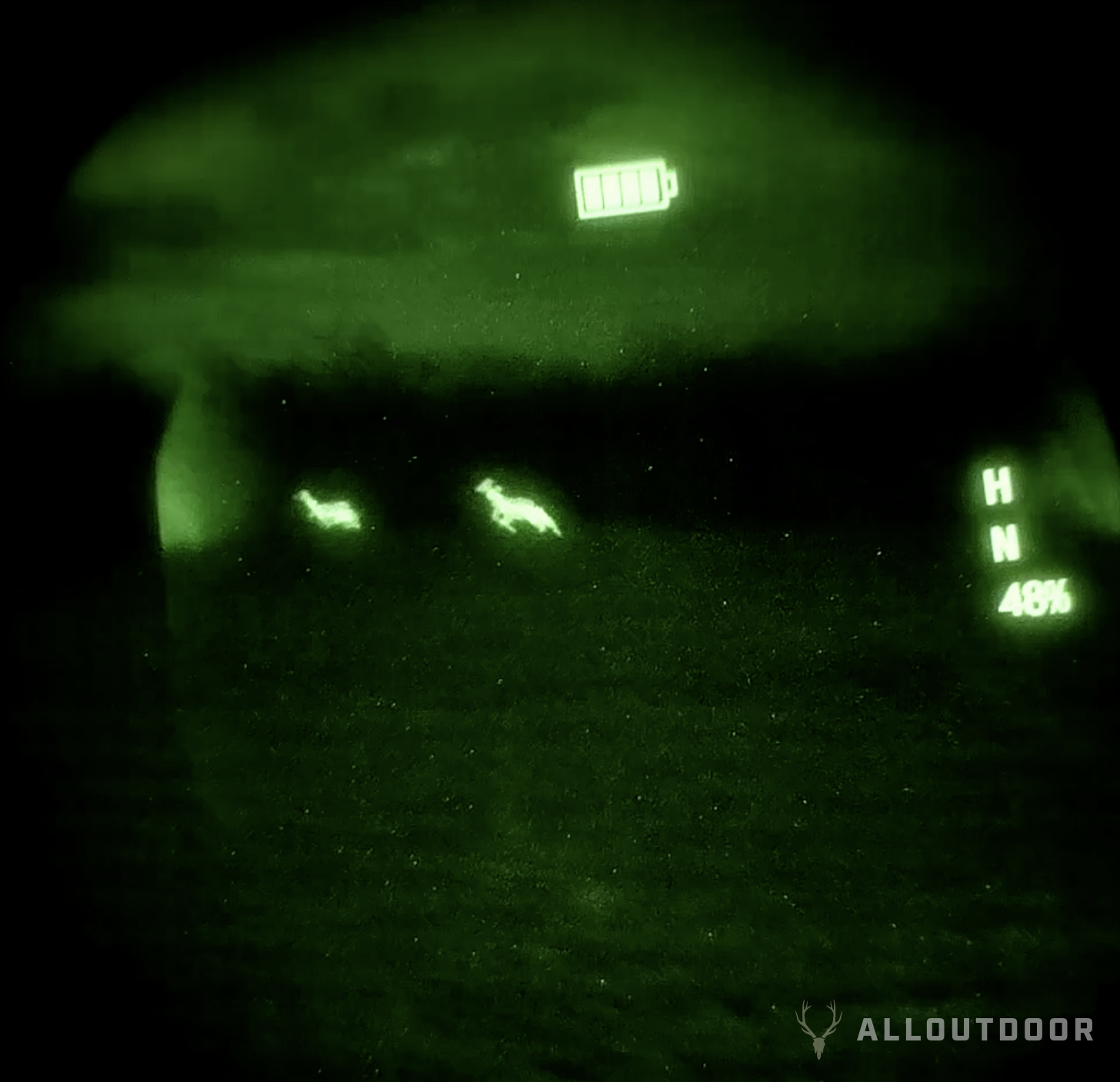
But further away? It is almost impossible to tell. See the hot specks below? Are they cows? Or rocks? Or are they pigs?

Often the field of view on thermal monoculars or clip-on systems, for night vision goggles, has a limited field of view.
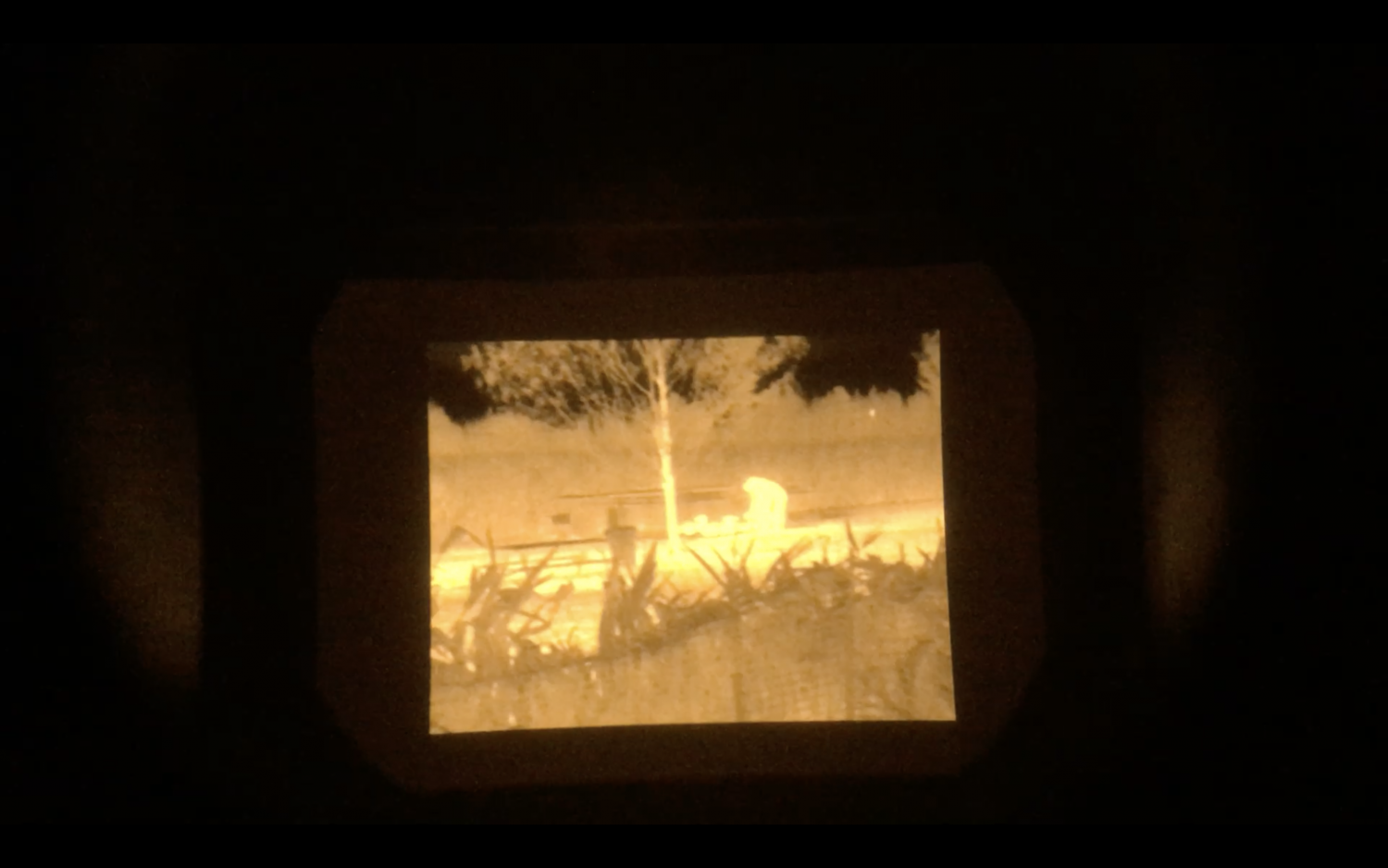
PSQ-20B thermal only.
Compare the image above with the image below. Analog night vision has 40º FOV. It is much greater than the thermal FOV.

Here is thermal fusion with digital night vision.
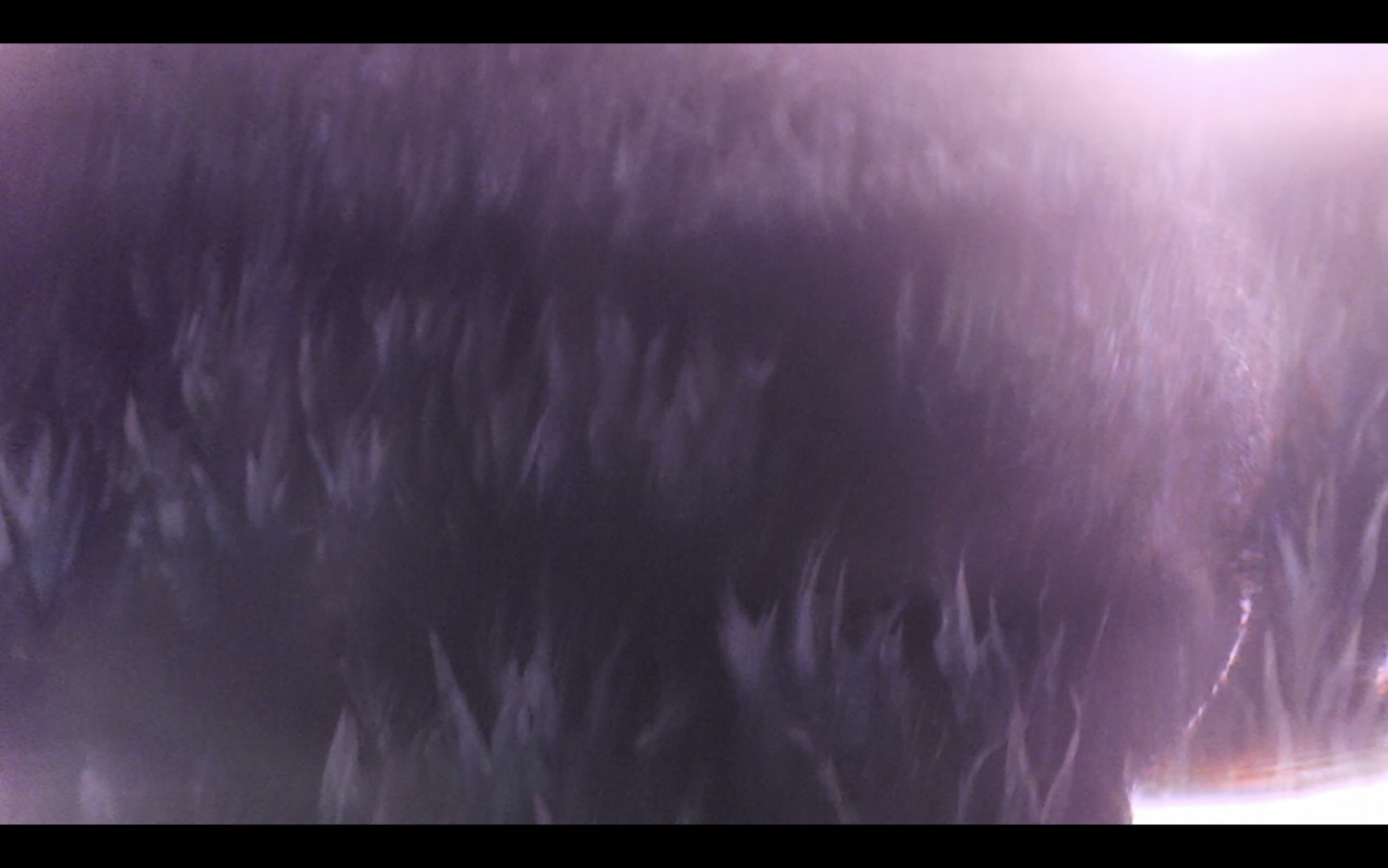
No thermal fusion. Just digital night vision.
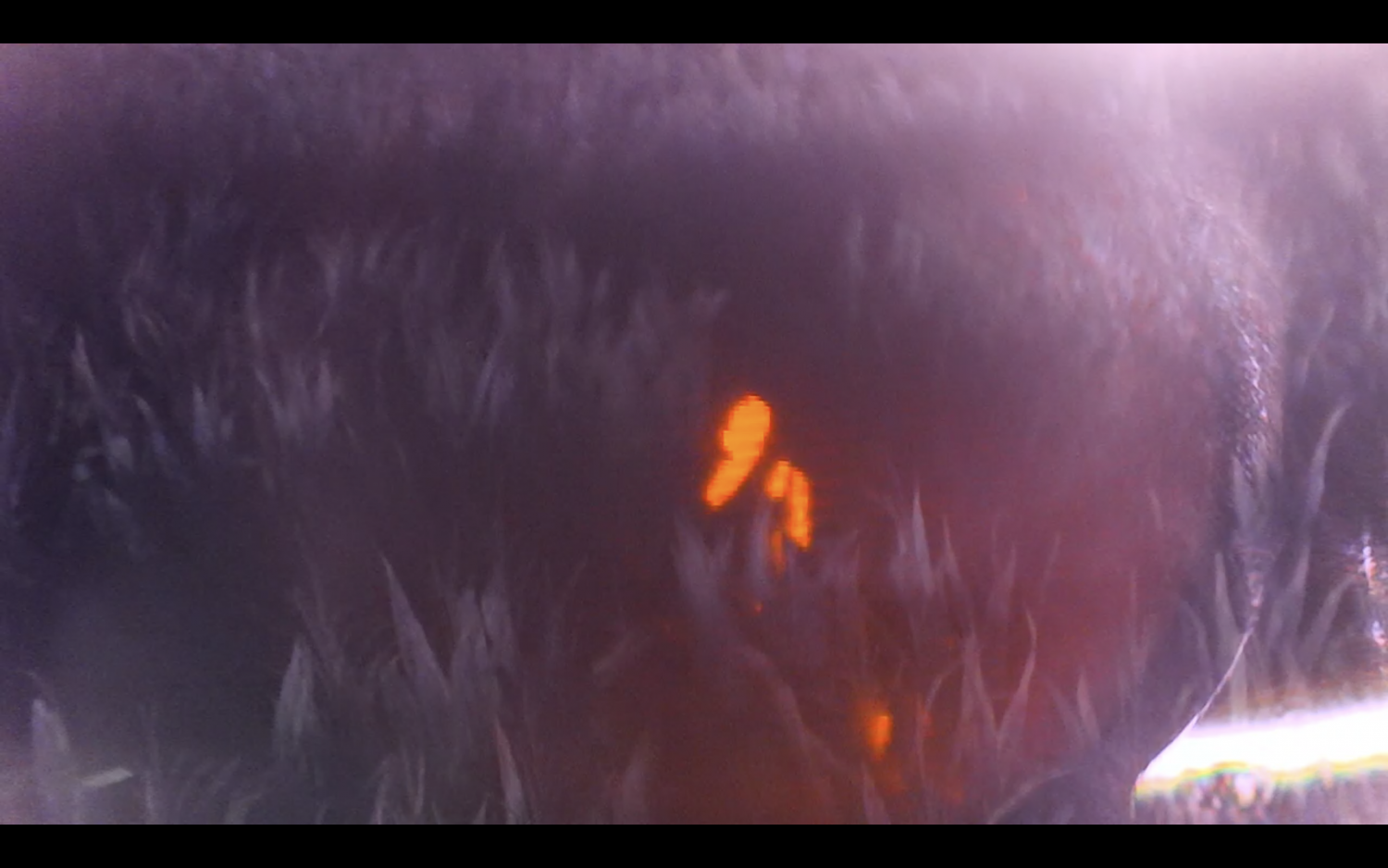
Thermal fusion.
You can see bodies in the corn with thermal.
Final Thoughts On Night Vision Or Thermal
Have you decided on night vision or thermal? Both systems are limited by the size of optics they have. However, thermal sees a much greater improvement with larger objectives than night vision. Like the UTCXII, I can see a cow 2,000 yards away and tell that it is a cow. However, it is a tool for a very specific task, shooting far. I remember using my COTI enhanced night vision on the hog hunt. Often I would be able to detect an animal far away but there was not enough resolution to help me recognize or identify the game we were looking for. Often we would have to bring out the larger thermal weapon scopes we were testing which had a higher base magnification making it easier to look at the potential target. 9 out of 10 times it was a calf or deer bedded down and not a feral hog.
Thermal is great for slow-paced activities like hunting. But in the night vision or thermal battle, night vision wins if you are doing things fast like driving a vehicle or running around and shooting. Sure you could use one to try and do everything but it will be less than ideal. Get the right tool for the right job.
Regardless of what you choose, save up money. Night vision or thermal is not cheap. Other than the boutique stuff like panos or long-range thermal sights, you can expect to spend up to several thousand dollars. Think about what activities you will be partaking and see what is most important to you. There is more you can do with night vision or thermal but for now, I hope this helps. Thanks for reading.
 Your Privacy Choices
Your Privacy Choices
